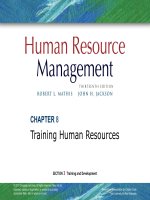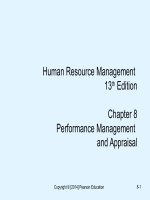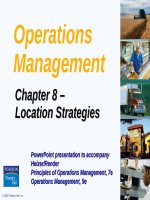Management by chuch williams chapter 08
Bạn đang xem bản rút gọn của tài liệu. Xem và tải ngay bản đầy đủ của tài liệu tại đây (1.88 MB, 47 trang )
Chapter 8
Global Management
MGMT
Chuck Williams
Designed & Prepared by
B-books, Ltd.
1
What Is Global Business?
After reading this section,
you should be able to:
1. discuss the impact of global business
and the trade rules and agreements
that govern it.
2
What Is Global Business?
Global Business
The buying and selling of goods and
services by people from different countries.
1
3
The Impact of Global
Business
Multinational Corporation
A corporation that owns businesses in
two or more countries.
Direct Foreign Investment
A method of investment in which a company
builds a new business or buys an existing
business in a foreign country.
1.1
4
Foreign Investment in the U.S.
1.1
5
U.S. Foreign Investment Abroad
1.1
6
Trade Barriers
Tariff
Tariff
Quotas
Quotas
Voluntary
Voluntaryexport
exportrestraints
restraints
Nontariff
Nontariff
Barriers
Barriers
Government
Governmentimport
importstandards
standards
Government
Governmentsubsidies
subsidies
Customs
Customsvaluation
valuation//classification
classification
1.2
7
Trade Agreements
General
GeneralAgreement
Agreement
on
onTariffs
Tariffsand
andTrade
Trade
Maastricht
MaastrichtTreaty
Treatyof
ofEurope
Europe
Regional
RegionalTrading
Trading
Zones
Zones
NAFTA
NAFTA
CAFTA
CAFTA
ASEAN
ASEANand
andAPEC
APEC
1.3
8
GATT
GATT made it easier and cheaper for consumers
in all countries to buy foreign products.
–
–
–
–
–
Tariffs were cut 40 percent on average worldwide by 2005
Tariffs were eliminated in 10 specific industries
Stricter limits were put on government subsidies
GATT established protections for intellectual property
Trade disputes between countries now are fully settled by
arbitration panels from the WTO
1.3
9
World Trade Organization
Location:
Geneva, Switzerland
Established: 1 January 1995
Created by: Uruguay Round
negotiations (1986-1994)
Membership: 153 countries
(as of 23 July 2008)
Budget: 185 million Swiss francs
for 2008
Secretariat staff: 625
Head: Pascal Lamy (directorgeneral)
1.3
Functions:
Administering WTO trade
agreements
Forum for trade negotiations
Handling trade disputes
Monitoring national trade
policies
Technical assistance and
training for developing
countries
Cooperation with other
international organizations
Web Link
Adapted from10
Fact File
Maastricht Treaty of Europe
• Formed in 1992 with
12 European countries
• Total membership is now
27 countries
• Transformed these countries into the European
Union, forming one economic market and one
common currency (the Euro)
• Opened up and simplified trade among member
nations
1.3
Web Link
/>11
NAFTA
• North American Free Trade
Agreement between Canada,
United States, & Mexico
• Liberalizes trade among these
three nations
• Eliminates most tariffs and
barriers
1.3
Web Link
/>12
CAFTA and USAN
• Central American Free
Trade Agreement
• Union of South
American Nations
• Fastest-growing place
for U.S. exports.
• Common infrastructure
to support trade.
1.3
13
ASEAN and APEC
• ASEAN
– Brunei Darussalam, Cambodia, Indonesia, Laos,
Malaysia, Myanmar, Philippines, Singapore,
Thailand, and Vietnam
• APEC
– Australia, Canada, Chile, China, Hong Kong, Japan,
Mexico, New Zealand, Papua New Guinea, Peru,
Russia, South Korea, Taiwan, United States, and
ASEAN members (except Cambodia, Laos, and
Myanmar)
1.3
Web Link
14
Consumers, Trade Barriers,
and Trade Agreements
American
consumers get
more for their
money
than most
other
consumers in
the world
because:
1.4
The U.S. marketplace is easiest for foreign companies to enter AND
the competitive market between domestic and foreign companies
keeps prices low.
15
Consumers, Trade Barriers,
and Trade Agreements
Increase:
Increase:
choices
choices
competition
competition
purchasing
purchasing power
power
Free
Free Trade
Trade
Agreements
Agreements
Decrease
Decrease price
price of:
of:
food
food
clothing
clothing
necessities
necessities
luxuries
luxuries
1.4
16
How to Go Global?
After reading these sections,
you should be able to:
2. describe why companies choose to standardize
or adapt their business procedures.
3. explain the different ways that companies
can organize to do business globally.
17
Consistency or Adaptation?
Global
Global
Consistency
Consistency
When
Whenaamultinational
multinationalcompany
companyhas
has
offices/plants
offices/plantsin
indifferent
differentcountries
countriesand
and
uses
usesthe
thesame
samerules,
rules,guidelines,
guidelines,
policies,
policies,and
andprocedures
procedures
Local
Local
Adaptation
Adaptation
When
Whenaamultinational
multinationalcompany
company
modifies
modifiesits
itsrules,
rules,guidelines,
guidelines,policies,
policies,
and
andprocedures
proceduresto
toadapt
adaptto
todifferences
differences
in
inforeign
foreigncustomers,
customers,governments,
governments,
and
andregulatory
regulatoryagencies
agencies
2
18
Forms for Global Business
Exporting
Cooperative
Contracts
Global
New
Ventures
Wholly Owned
Affiliates
Strategic
Alliances
3
19
Exporting
Advantages
Less
Lessdependence
dependence on
on home
homemarket
marketsales
sales
Greater
Greater degree
degreeof
of control
controlover
over research,
research,
design,
design,and
andproduction
productiondecisions
decisions
3.1
20
Exporting
Disadvantages
Many
Manyexports
exportsare
aresubject
subject to
totariff
tariff
and
andnontariff
nontariffbarriers
barriers
Transportation
Transportation costs
costscan
can increase
increaseprice
price
Companies
Companiesmay
maydepend
dependon
on foreign
foreign
importers
importersfor
for product
productdistribution
distribution
3.1
21
Cooperative Contracts
3.2
Licensing
Licensing
AAdomestic
domesticcompany
companyreceives
receivesroyalty
royalty
payments
paymentsfor
forallowing
allowinganother
another
company
companyto
toproduce
produceits
itsproduct,
product,sell
sell
aaservice,
service,or
oruse
useits
itsbrand
brandname
namein
inaa
specified
specifiedforeign
foreignmarket
market
Franchising
Franchising
AAcollection
collectionof
ofnetworked
networkedfirms
firmsin
in
which
whichthe
themanufacturer
manufactureror
ormarketer
marketerof
of
aaproduct/service
product/servicelicenses
licensesthe
theentire
entire
business
businessto
toanother
anotherperson
personor
or
organization
organization
22
Licensing
Advantages
Allows
Allowscompanies
companiesto
toearn
earn profits
profitswithout
without
investing
investingmore
moremoney
money
The
The licensee
licenseeinvests
investsin
inproduction
production
equipment
equipmentand
andfacilities
facilities
Helps
Helpscompanies
companiesavoid
avoidtariff
tariff and
and
nontariff
nontariffbarriers
barriers
3.2
23
Licensing
Disadvantages
Licensor
Licensorgives
givesup
up control
controlover
over quality
quality
of
ofthe
the product
productor
or service
service sold
soldby
by the
the
foreign
foreign licensee
licensee
Licensees
Licenseescan
can eventually
eventually become
become
competitors
competitors
3.2
24
Franchising
Advantages
Fast
Fastway
wayto
toenter
enter foreign
foreignmarkets
markets
Good
Goodstrategy
strategywhen
when aacompany’s
company’s
domestic
domesticsales
saleshave
haveslowed
slowed
3.2
25









